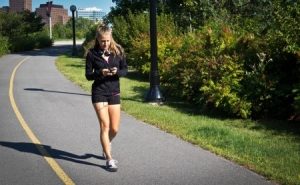During vigorous walking, the heart beats more rapidly, helping to strengthen the heart muscle. A strong muscle can help lower high blood pressure and reduce the risk of heart attack or stroke. Exercise allows the heart to pump blood more efficiently, improving blood circulation. Walking causes greater capacity, easing breathing and improving the entire respiratory system. It also helps tone muscles in legs, thighs and abdomen.
Walking is an effective exercise when you walk briskly for at least 20 minutes at a constant clip of 3 to 4 miles per hour. Walking as an exercise can:
- relieve tension
- provide an effective weight control means
- promote physical fitness
- enhance a person’s general attitude toward life
- keep the body energized
CALORIES & WALKING
Brisk walking burns approximately the same amount of calories per mile as does running. Heavier individuals will burn more calories than lighter persons. For example, a 110-pound person burns about half as many calories as a 216-pound person walking at the same pace for the same distance. Although increasing walking speed does not burn significantly more calories per mile, a more vigorous walking pace will produce more dramatic conditioning effects.
CORRECT WALKING
You may not have thought about it, but there is a correct way to walk. With each step, the body’s weight is borne by the foot. From the heel to the base of the big toe. A step starts at the heel, moves to the outside of the foot and then rolls off the big toe. Taking a step is a kind of balancing act, and sometimes it may be off kilter.
Look at the heel of your shoe. If it’s worn down on one side, your weight is not evenly distributed. That is an indication that just a portion of the heel, instead of your entire heel, is absorbing the pressure when you walk. Over time, this can strain muscles and tendons in your feet and legs.
Correct posture is important when you walk. The ideal walking position is to hold your head erect, keeping your back straight, letting your arms swing freely at your sides and taking long, easy strides.
WALKING PACE
Leisurely strolls do not count as walking exercise. If you are in good health, you need to set a goal for the pace you would like to achieve, but start slowly. Set a target zone for the heartbeat, according to your age. Your target zone should be 60% to 80% of your maximum heart rate.
If you are in poor physical condition, a speed of 3 miles per hour for 30 minutes may bring your heart rate into the target zone for your age.
If you are in excellent condition, you may have to walk 4 to 5 miles per hour for 30 to 60 minutes to reach your target.
HOW FAR AND HOW FAST?
Don’t expect to walk 10 miles the first time out. Start slowly. Walking, like any vigorous exercise, requires moderation until the body has built some stamina. You know you are walking a good clip when you are taking about 120 steps per minute.
Begin by walking at a relaxed pace for 10 minutes, working up to 20 minutes every other day at a brisk pace. After you have been walking briskly for 20 minutes three days a week for one month, increase your walking time to 30 minutes. Repeat 30-minute walks four or five times a week.
Take the talk test as you walk. If you can’t carry on a conversation without becoming breathless, you are going too fast.
SHOES
A pair of good shoes is the only special equipment required. Any shoes that are comfortable, provide good support and don’t cause blisters or calluses will do. Whatever shoe you use should have arch supports and should elevate the heel one-half to three-quarters of an inch above the sole of the foot.
While walking, wear shoes with uppers made of materials that permit your feet to “breathe”. The best show materials are leather, canvas or nylon mesh. Allow one-fourth to one-half inch of space between the longest toe and the tip of the shoe. This will give your feet room to expand while walking. An exercise shoe, just like any other shoe, must be comfortable in the store. Don’t try to “break in” an uncomfortable shoe.
**Anyone over the age of 50, overweight, having high blood pressure, respiratory or cardiovascular problems is advised to consult a physician before starting a walking program.
Robert Bovee Certified Master PPT, RTS, ETS, FTS
As one of the most successful Professional Personal Trainers and Exercise/Fitness Therapists in the United States, Robert continues to remain at the forefront of the industry by providing his clients with a thorough education and the tools to implement that education. By improving his client’s physical health, strength, endurance, cardiovascular fitness and nutritional habits, he is able to motivate them to lead longer, happier and more productive lives. Find out more about Robert and his personal training career and services, here.
Guest authors offer experience and educational insights based on their specific area of expertise. These authors are contributing writers for the NFPT blog because they have valuable information to share with NFPT-CPTs and the fitness community at-large. If you are interested in contributing to the NFPT blog as a guest, please send us a note expressing your interest and tell us how you can contribute valuable insights to our readers. We look forward to hearing from you! Send to editor@nfpt.com

